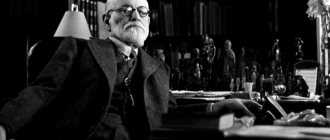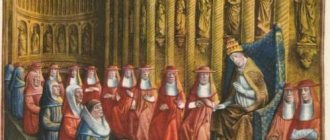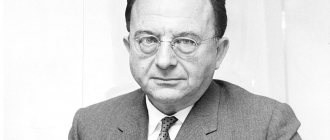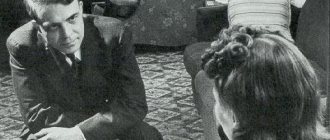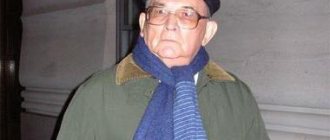Sigmund Freud
(1856 - 1939) - famous Austrian psychologist, founder of psychoanalysis - a direction that had a decisive influence on modern psychology, literature, art, medicine, anthropology, and sociology. The significance and authority of Freud's scientific work have long caused heated debate, which continues in our time.
Biography
Sigmund Freud - Austrian psychoanalyst, psychiatrist and neurologist. Founder of psychoanalysis. He proposed innovative ideas that resonate in scientific circles even today.
Sigmund Freud was born in the city of Freiberg (now Příbor, Czech Republic) on May 6, 1856, becoming the third child in the family. Sigmund's mother is the second wife of Jacob Freud, who already had two sons from his first marriage. Trade in fabrics brought the family profit, which was enough to live on. But the outbreak of the revolution trampled even such a small initiative against the background of other ideas, and the family had to leave their home. First, the Freud family moved to Leipzig, and a year later to Vienna.
A poor area, dirt, noise and unpleasant neighbors are the reasons that did not create a positive atmosphere in the house of the future scientist. Sigmund himself did not like to remember his early childhood, considering those years unworthy of his own attention.
Sigmund Freud as a child with his father
The parents loved their son very much and had high hopes for him. Passion for literature and philosophical works was only encouraged. But Sigmund Freud did not read childish, serious literature. In the boy’s personal library, the works of Shakespeare, Kant, Nietzsche and Hegel occupied a place of honor. In addition, the psychoanalyst was fond of studying foreign languages, and even complex Latin was surprisingly easy for the young genius.
Studying at home allowed the boy to enter the gymnasium earlier than expected. During his school years, conditions were created for Sigmund to unhindered completion of assignments in various subjects. Such love from his parents was fully justified, and Freud graduated from high school successfully.
After school, Sigmund spent many days alone, thinking about his future. Strict and unjust laws did not give a Jewish boy much choice: medicine, law, commerce and industry. All options, except the first, were immediately discarded by Sigmund, considering them unsuitable for such an educated person. But Freud had no particular interest in medicine either. In the end, the future founder of psychoanalysis chose this science, and psychology will become the basis for the study of various theories.
Sigmund Freud (third in the top row, left to right) as a young man with his family, 1878
The impetus for the final decision was a lecture at which Goethe’s work entitled “Nature” was read. The future philosopher studied medicine without his usual zeal and interest. During his student years in Brücke's laboratory, Freud published interesting and informative articles on the nervous system of some animals.
After graduation, Sigmund planned to continue his academic career, but the environment required the ability to earn a living. Therefore, after working for several years under some famous therapists of that time, in 1885 Sigmund Freud applied to open his own neuropathology office. Thanks to the recommendations, the scientist received permission.
It is known that Sigmund also tried cocaine. The effect of the drug amazed the philosopher, and he wrote a large number of works in which he revealed the properties of the destructive powder. One of Freud's closest friends died as a result of cocaine treatment, but the enthusiastic explorer of the secrets of human consciousness did not pay due attention to this fact. After all, Sigmund Freud himself suffered from cocaine addiction. After many years and a lot of effort, the professor finally recovered from his addiction. All this time, Freud did not abandon his studies in philosophy, attending various lectures and keeping his own notes.
The last days of the great scientist
The scientist spent the best years of his life in constant search and work. Freud's death shocked many. The man suffered from pain in the throat and mouth. A tumor was later found, due to which he underwent dozens of surgeries, losing the pleasant appearance of his face. Over the years of his life, S. Freud managed to make important contributions to many areas of human life. It would seem that with a little more time, he would have created much more.
But, unfortunately, the disease took its toll. The man made an agreement in advance with his attending physician, and when he no longer wanted to endure it, and there was no need to force all his relatives to watch this, S. Freud turned to him and said goodbye to this world. After the injection, he calmly fell into an eternal sleep.
Psychotherapy and psychoanalysis
In 1885, thanks to the support of friends, influential luminaries of medicine, Sigmund Freud got an internship with the French psychiatrist Jean Charcot. The practice opened the eyes of the future psychoanalyst to the differences between diseases. From Charcot, Freud learned to use hypnosis in treatment, with the help of which it was possible to cure patients or alleviate suffering.
Top row: Abraham Brill, Ernest Jones, Sandor Ferenczi. Bottom row: Sigmund Freud, Granville S. Hall, Carl Gustav Jung
Sigmund Freud began to use conversations with patients in treatment, allowing people to speak out and change their consciousness. This technique became known as the “Free Association Method”. These conversations of random thoughts and phrases helped the astute psychiatrist understand the patients' problems and find solutions. The method helped to abandon the use of hypnosis and pushed me to communicate with patients in full and clear consciousness.
Freud introduced the world to the view that all psychosis is a consequence of a person’s memories, which are difficult to get rid of. At the same time, the scientist came up with the theory that most psychoses are based on the Oedipus complex and infantile childhood sexuality. Sexuality, as Freud believed, is the factor that determines a large number of human psychological problems. “Three Essays on the Theory of Sexuality” supplemented the scientist’s opinion. Such a statement based on structured works caused scandals and disagreements among Freud's psychiatrist colleagues who opposed the theory. Representatives of the scientific community said that Sigmund was delusional, and he himself, as experts suggested, was a victim of psychosis.
Sigmund Freud
The publication of the book “The Interpretation of Dreams” initially did not bring the author due recognition, but later psychoanalysts and psychiatrists recognized the importance of dreams in the treatment of patients. According to the scientist, dreams are a significant factor influencing the physiological state of the human body. After the release of the book, Professor Freud was invited to give lectures at universities in Germany and the USA, which the representative of medicine himself considered a great achievement.
The Psychopathology of Everyday Life is another of Freud's works. This book is considered the second work after The Interpretation of Dreams, which influenced the creation of the topological model of the psyche developed by the scientist.
Sigmund Freud's arrival in London, 1938
The book “Introduction to Psychoanalysis” took a special place among the scientist’s works. This work contains the core of the concept, ways of interpreting the theoretical principles and methods of psychoanalysis, as well as the philosophy of thought of the author. In the future, the basics of philosophy will become the basis for creating a set of mental processes and phenomena that have received a new definition - “Unconscious”.
Freud also tried to explain social phenomena. In the book “Psychology of the Masses and Analysis of the Human Self,” the psychoanalyst discussed the factors that influence the crowd, the behavior of the leader, and the “prestige” obtained as a result of being in power. All of these books by the author are still bestsellers.
Sigmund Freud at work
In 1910, there was a split in the ranks of Freud's students and followers. The students’ disagreement with the fact that psychosis and hysteria are associated with the suppression of human sexual energy (this theory was adhered to by Freud) is the reason for the contradictions that led to the split. Disagreements and strife tired the great psychiatrist. The psychoanalyst decided to gather around himself only those who adhered to the basics of his theory. Thus, in 1913, a secretive and almost secret community, the “Committee,” appeared.
Was Freud preoccupied or are these people prudes?
Now let’s remember the famous “Freudian slip”.
The scientist was sure that life is filled with associations with sex. A typical bigot will now begin to claim that only the preoccupied and idle are constantly thinking about such “animal things”, but this is not so.
The most common association: banana - erect penis - phallus. This trilogy created a stir in every country in the world where there are those who are not indifferent to Freud or have at least heard of him.
The psychoanalyst was accused of looking at the world through the glasses of sexuality
and generally “sexually preoccupied.” This cannot be ruled out either, but he imbued the analysis of dreams, paintings, and novels of the unconscious with sexual symbols.
Freud's contemporaries were less fortunate than us - their sex life could hardly be called happy, because in their times relations between the sexes were strictly regulated. Many prohibitions gave rise to anxious thoughts - sexual energy accumulated and settled inside.
If the relationship between a man and a woman was strictly regulated, then homosexuality and other “perversions” were generally taboo. But Freud and his students and supporters were the first to volunteer to change this.
Medical status allowed scientists to openly express a positive attitude towards such things
, in which they succeeded significantly, despite the moralists and bigots of those times (who probably also were not averse to letting go of their “correctness” and having a blast).
Personal life
For decades, Sigmund Freud paid no attention to the female gender. Frankly speaking, the scientist was afraid of women. This fact caused a lot of jokes and gossip, which embarrassed the psychiatrist. Freud convinced himself that he could live his whole life without women interfering in his personal space. But circumstances developed in such a way that the great scientist succumbed to the influence of the charm of the fair sex.
Sigmund Freud and Martha Beirnais
One day, on the way to the printing house, Freud almost fell under the wheels of a carriage. The passenger, who regretted the incident, sent the scientist an invitation to the ball as a sign of reconciliation. Already at the event, Sigmund Freud met his future wife Martha Beirnais, as well as her sister Minna. After some time, a magnificent engagement took place, and then a wedding. Married life was often overshadowed by scandals; jealous Martha insisted that her husband break off communication with Minna. Not wanting to quarrel with his wife, Freud did just that.
Sigmund Freud with his daughter Anna
Over 8 years of family life, Martha gave her husband six children. After the birth of his youngest daughter Anna, Sigmund Freud decided to completely renounce sex. Judging by the fact that Anna became the last child, the great psychoanalyst kept his word. It was the youngest daughter who looked after Freud at the end of the scientist’s life. In addition, Anna is the only one of the children who continued the work of their famous father. A children's psychotherapy center in London is named after Anna Freud.
[edit] Links
- https://www.lib.ru/PSIHO/FREUD/
- Bibliography in Russian // psychoanalysis.pro
- Proven: Sigmund Freud cheated on his wife
| [+] Psychology | |
| Sections | General psychology • Acmeology • Differential psychology • Psychogenetics • Psychodiagnostics • Psycholinguistics • Psychology of perception (smell, color, sound, taste, tactile perception) • Personality psychology • Developmental psychology • Psychophysiology • Social psychology • Special psychology • Comparative psychology • Evolutionary psychology • Experimental psychology • Gender psychology |
| Applied | Engineering psychology • Clinical psychology • Musical psychology • Neuropsychology • Pathopsychology • Psychological assistance • Psychology of money • Health psychology • Psychosomatics • Psychotherapy • Educational psychology • Sports psychology • Labor psychology • Management psychology • Family psychology • Economic psychology • Legal psychology • Parenting psychology • Psychographics |
| Directions (schools) | Associationism • Behaviorism • Functionalism • Structuralism • Psychoanalysis • Analytical psychology • Gestalt psychology • Cultural-historical psychology • Activity theory • Cognitive psychology • Humanistic psychology • Existential psychotherapy • Rational-emotive-behavioral therapy • Transpersonal psychology • Transactional analysis • Cyberacmeology |
| Outstanding psychologists | Alfred Adler • Gordon Allport • Albert Bandura • George Kelly • Raymond Cattell • Erik Erikson • Hans Eysenck • Leon Festinger • Viktor Frankl • Sigmund Freud • Donald Hebb • William James • Carl Jung • Kurt Lewin • Abraham Maslow • Stanley Milgram • George Miller • Ivan Pavlov • Lev Vygotsky • Alexei Leontiev • Alexander Luria • Jean Piaget • Carl Rogers • Edward Thorndike • John Watson • Burres Skinner • Wilhelm Wundt • Max Wertheimer • Wolfgang Köhler • Kurt Koffka • Frederick Perls • Eric Berne |
Interesting Facts
The biography of Sigmund Freud is full of interesting stories.
- It is known that the psychoanalyst was afraid of the numbers 6 and 2. The scientist never stayed in hotels that had more than 61 rooms. Thus, Freud avoided ending up in the “hell room” number 62. In addition, under any pretext, on February 6, the Austrian did not go out into the street, he was afraid of the negative events that, as the scientist assumed, were expected on that day.
Portrait of Sigmund Freud
- Freud listened only to himself, considering his own opinion to be the only true and correct one. The scientist demanded that people listen to the speeches very carefully. Surely, not just one theory of the scientist is connected with these moments, but with similar demands on others, the psychoanalyst tried to prove his superiority, satisfying his pride.
- The psychiatrist’s phenomenal memory is another mysterious moment in the biography of the Austrian doctor. Since childhood, the scientist memorized the contents of books, notes and pictures that he liked. Such abilities helped Freud in learning languages. The famous Austrian, in addition to German, knew a large number of other languages.
One of the last photos of Sigmund Freud, 1939
- Sigmund Freud never looked people in the eye. This feature was clearly noticed by those around him who met the doctor during his lifetime. The scientist avoided looking, so representatives of the scientific community suggest that the famous couch that appeared in the psychoanalyst's room is connected with this moment.
What are the most typical Freudian slips?
Freud's followers conducted many tests, studied a person's reaction to their reservations, revealing their hidden sexual overtones. To conduct one of them, they invited three groups of men, an attractive girl, and took a stun gun.
.
One
the group was greeted by a laboratory assistant in a short skirt and a translucent blouse, and the other two by a middle-aged professor. Participants in the experiment were asked to read certain pairs of words, one per second - these were expressions in which people often switch syllables. For example: not “a glass of champagne”, but “a glass of champagne”.
Following a sound signal, he had to name these phrases in turn. Now is the time to remember Freud, because what happened next is what he talked about. The men who met the seductive laboratory assistant made more blunders with sexual overtones in the spirit of: “naked howl” or “smooth sex” instead of “wash your hair” and “sweet cupcake”.
Participants of the third
The groups attached electrodes to their fingers that created weak impulses. They were told there was at least a 70% chance of getting hit, which was an outright lie. Here, too, they made a mistake, betraying their true thoughts that worried them at that moment: not “Kok Tolka,” but “Kok Kolka.”
When measuring the level of sexual anxiety, it turned out that it was higher among those who made the most reservations
with sexual overtones. Wanting to suppress the desire, the men were sentenced faster. This trap is called the “polar bear problem,” which was first noticed by writer Leo Tolstoy. He said that if you try your best not to think about something, that’s all that will be in your head.
Death
Intensive study of medical and philosophical works, a busy daily routine and the work of a thinker left a heavy imprint on Sigmund Freud’s health. An Austrian psychoanalyst fell ill with cancer.
Having undergone a large number of operations and not getting the desired result, Freud asked the attending physician to provide a favor and help him die, free from pain. In September 1939, a dose of morphine ended the scientist’s life, consigning his body to dust.
Sculpture of Sigmund Freud at Madame Tussauds in Berlin
A large number of museums have been created in Freud's honor. The main such institution was organized in London, in the building where the scientist lived after forced emigration from Vienna. Also, the museum and hall in memory of Sigmund Freud is located in the city of Příbor (Czech Republic), in the scientist’s homeland. The photo of the founder of psychoanalysis is often found at international events dedicated to psychology.
[edit] Literature
- Dadun, Roger. Freud - M.: H. G.S., 1994. - 512 p. — ISBN 5-7588-0040-6.
- Jones E. The Life and Works of Sigmund Freud / trans. from English V. Starovoitova - M.: Humanitarian AGI, 1996. - 448 p. — ISBN 5-89221-006-5.
- Casafont, Josep Ramon. Sigmund Freud / trans. from Spanish A. Berkova - M.: AST, 2006. - 253 p. — (Biography and creativity). — ISBN 5-17-037281-7.
- Ferris P. Sigmund Freud / trans. from English Ekaterina Martinkevich - Mn.: Poppuri, 2001. - 448 p. — ISBN 985-438-526-4.
- Fromm E. Greatness and limitation of Freud's theory = Greatness and Limitation of Freud's Thought (1979) - Moscow: AST, 2000. - 448 p. — (Classics of foreign psychology). — 5000 copies. — ISBN 5-237-04524-3.
- Yaroshevsky M. G. Sigmund Freud - an outstanding researcher of human mental life // Freud, Sigmund. Psychology of the unconscious - St. Petersburg, 2002. - 400 p. - (Masters of Psychology). — ISBN 5-94723-092-5.
- Hans Jurgen Eysenck. Sigmund Freud. The decline and end of psychoanalysis (Publishing house "Liszt-Verlag", Munich, 1985. Russian translation and publication on the Internet 2016)
Quotes
- “Love and work are the cornerstones of our humanity.”
- “The task of making man happy was not part of the plan for the creation of the world.”
- “The voice of intellect is quiet, but it never tires of repeating – and there are listeners.”
- “You never stop looking for strength and confidence outside, but you should look within yourself. They have always been there."
- “In a number of cases, falling in love is nothing more than a psychic capture by an object, dictated by sexual primary urges for the purpose of direct sexual satisfaction and, with the achievement of this goal, fading away; this is what is called base, sensual love. But, as we know, the libidinal situation rarely remains so uncomplicated. Confidence in a new awakening of a need that had just died out was probably the immediate motive why the capture of a sexual object turned out to be long-lasting and it was “loved” even during those periods of time when there was no desire.”
- “Just today my deceased daughter would have turned thirty-six years old... We are finding a place for the one we lost. Although we know that the acute grief after such a loss will be erased, we remain inconsolable and will never be able to find a replacement. Everything that stands in an empty place, even if it manages to fill it, remains something else. That's how it should be. This is the only way to prolong the love that we do not want to renounce.” — from a letter to Ludwig Binswanger, April 12, 1929.
Theory of the unconscious
Trying to find these very unconscious motives - possible causes of neuroses, he drew attention to the unsatisfied desires of a person in the past, which lead to personality conflicts in the present. These alien emotions seem to cloud the consciousness. They were interpreted by him as the main evidence of the existence of the unconscious .
In 1902, Sigmund was given the position of professor of neuropathology at the University of Vienna, and a year later he became the organizer of the “First International Psychoanalytic Congress”. But international recognition of his achievements came only in 1930, when the city of Frankfurt am Main awarded him the Goethe Prize .
